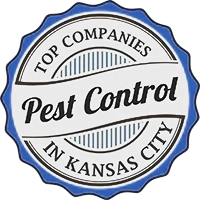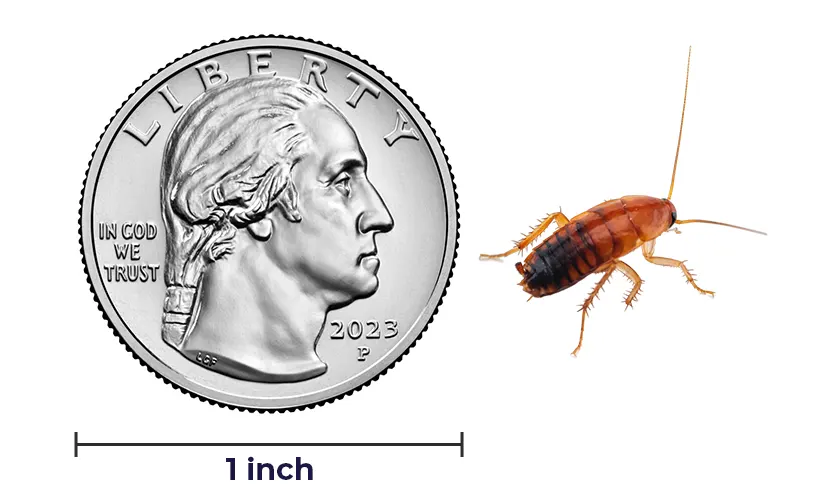
If you’ve come across a small bug that you suspect might be a baby cockroach and are concerned about potential infestations, you’re in the right place. In this article, we’ll provide you with essential information about what different types of baby cockroaches look like, how to distinguish them from other insects, and, most importantly, how to handle the situation effectively. Let’s begin by shedding light on the appearance of baby cockroaches.
Table of Contents
What Do Baby Cockroaches Look Like?
Baby Cockroach Characteristics
Baby cockroaches, also known as nymphs, are miniature versions of their adult counterparts. Their appearance varies depending on the cockroach species, but they generally share some common features:

Size, Color & Body Shape
Baby cockroaches are tiny, typically ranging from 1/8 inch to 1/2 inch in length, depending on their age and species. Most baby cockroaches are light to dark brown or reddish-brown.
They have flattened, oval-shaped bodies with three distinct body segments: the head, thorax, and abdomen.
Nymphs have long, thread-like antennae that extend from their heads. Like adult cockroaches, baby cockroaches have six spiny legs that are well-suited for scuttling across surfaces.
Cockroach Species Variation
Different cockroach species may have slight variations in appearance, making it important to recognize these differences. Here’s a brief overview of the most common house cockroach species and their nymphs, along with which ones you’re most likely to find in your home.
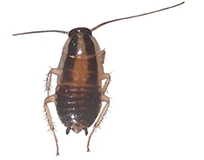
German Cockroach Nymphs
Small in size with a tan to light brown color. German cockroaches are among the most common indoor pests, so you’re more likely to encounter their nymphs indoors, especially in kitchens and bathrooms.
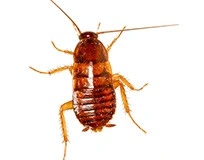
American Cockroach Nymphs
Larger and can be darker in color, ranging from reddish-brown to nearly black. American cockroaches are typically found in damp, dark areas like basements and crawl spaces. You might encounter their nymphs in these locations.
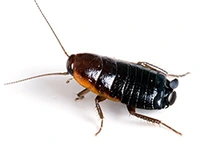
Oriental Cockroach Nymphs
Dark brown to black with a shiny appearance. Oriental cockroaches prefer cool, damp environments and are often found in basements and around drains. You may come across their nymphs in these areas.
Baby cockroaches go through several nymph stages, shedding their exoskeleton as they grow. This process, called molting, results in their coloration becoming darker as they reach adulthood.
Baby Cockroaches versus Similar-Looking Bugs
So you found a strange looking bug in your home and you may wonder “is it a baby cockroach?”. While baby cockroaches may resemble other insects, there are key differences to help you identify them correctly.
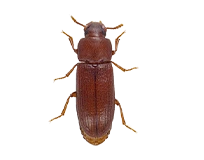
Red Flour Beetles vs Baby Cockroaches
Red flour beetles are elongated and reddish-brown but have distinct antennae and a more elongated body compared to baby cockroaches.
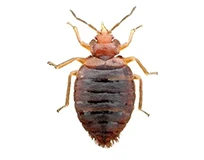
Bed Bugs vs Baby Cockroaches
Bed bugs are smaller than baby cockroaches and have a different body shape. Bed bugs are oval, reddish-brown, and flat, with no antennae as prominent as those of cockroaches. Learn pro tips on how to keep bed bugs away from your home.
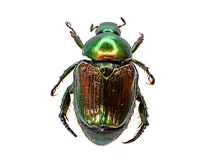
Japanese Beetles vs Baby Cockroaches
Japanese beetles are small, metallic green or bronze beetles with a different body shape and coloration.
How to Get Rid of Baby Cockroaches
If you’ve identified baby cockroaches in your home, it’s crucial to take action promptly to prevent an infestation. Cockroaches are notorious for their rapid reproduction. A single female cockroach can lay numerous eggs in her lifetime, with some species capable of producing up to 300 offspring in just a year.
They typically lay their eggs in hidden, sheltered locations, making it essential to address the issue swiftly. Here are some steps to consider in your battle against baby cockroaches:
Identify Entry Points
Locate and seal any cracks or openings where cockroaches may be entering your home. Pay especially close attention to dark, hidden areas such as bathroom and kitchen cabinets.
Eliminate Food and Water Sources
Cockroaches are attracted to food and water. Keep your kitchen clean, store food in airtight containers, and fix any leaky pipes in your kitchen, bathrooms and HVAC room.
Professional Pest Control
For a severe infestation, it’s best to consult with a pest control company who can assess the situation and implement effective treatments. Cockroach infestations are some of the most difficult to deal with as a homeowner and can be next to impossible to eradicate with DIY pest control solutions.
Use Baits and Traps
Cockroach baits and traps can be effective in reducing the population. Make sure to place them in areas where you’ve seen roach activity.
Need Help With Cockroaches?
Call or Text Blue Beetle Today!
Roach infestations are covered by our quarterly pest control service. This is why we recommend year-round protection with our Happy Home Program!
FAQ’s About Baby Cockroaches
How do you identify a baby cockroach?
To identify a baby cockroach, look for its small size, brownish color, flattened body, and long antennae.
What do baby cockroaches eat?
Baby cockroaches, like adults, feed on a variety of organic matter, including food scraps, crumbs, and even paper.
How do you find a cockroach nest?
Cockroach nests are typically located in warm, dark, and humid areas, such as behind appliances, in cabinets, or under sinks.
What can be mistaken for a baby roach?
Other insects like bed bugs, carpet beetles, and even certain beetles may be mistaken for baby cockroaches due to their size and coloration.
How do you find a cockroach nest?
Cockroach nests are typically located in warm, dark, and humid areas, such as behind appliances, in cabinets, or under sinks.
What kills cockroaches instantly?
Cockroach sprays, baits, and traps are commonly used to kill cockroaches, but it may take some time for the effects to be noticeable.
If you think you may be dealing with a cockroach infestation or have more questions, don’t hesitate to reach out to cockroach exterminators near you. Your home’s comfort and hygiene are at stake, and we’re here to help you keep it pest-free with same-day pest control services.



